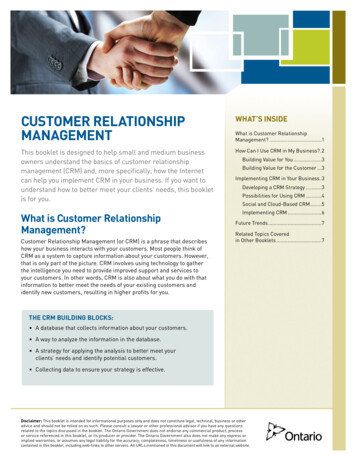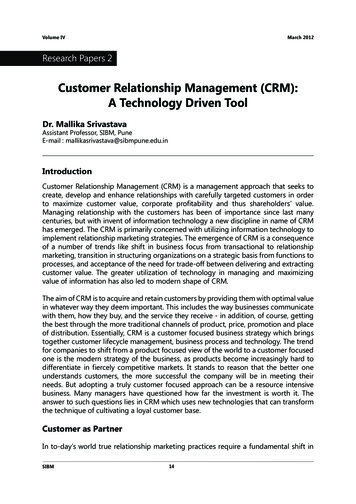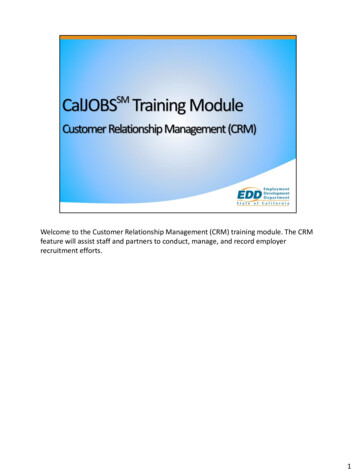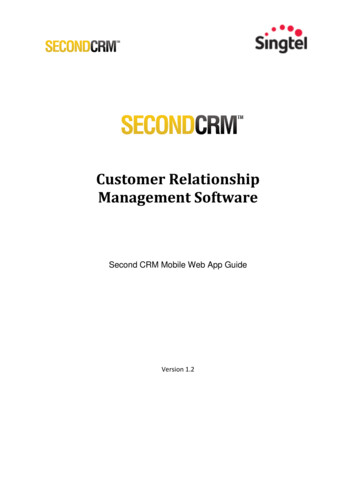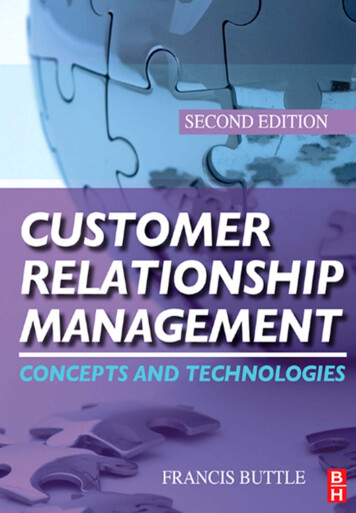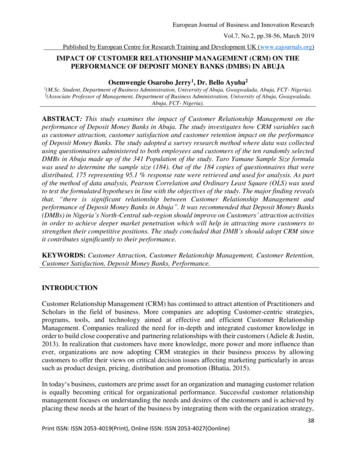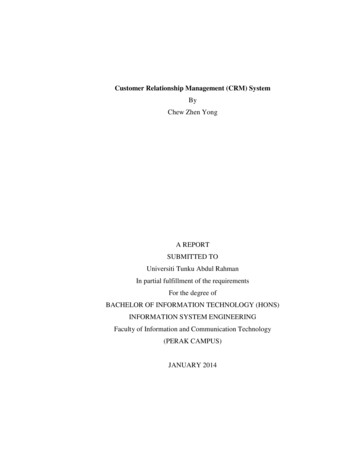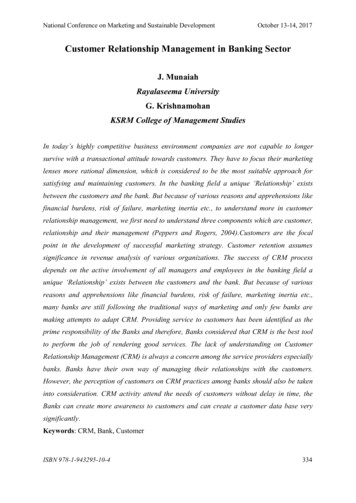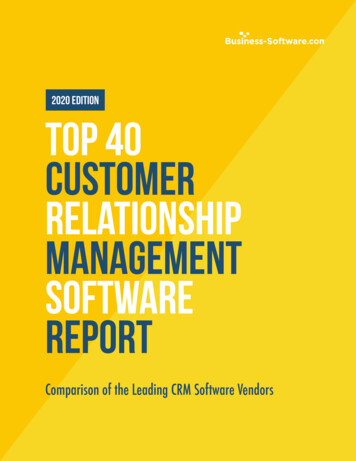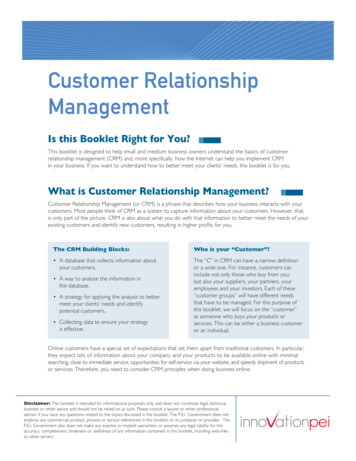
Transcription
Customer RelationshipManagementIs this Booklet Right for You?This booklet is designed to help small and medium business owners understand the basics of customerrelationship management (CRM) and, more specifically, how the Internet can help you implement CRMin your business. If you want to understand how to better meet your clients’ needs, this booklet is for you.What is Customer Relationship Management?Customer Relationship Management (or CRM) is a phrase that describes how your business interacts with yourcustomers. Most people think of CRM as a system to capture information about your customers. However, thatis only part of the picture. CRM is also about what you do with that information to better meet the needs of yourexisting customers and identify new customers, resulting in higher profits for you.The CRM Building Blocks:Who is your “Customer”? A database that collects information aboutyour customers.The “C” in CRM can have a narrow definitionor a wide one. For instance, customers caninclude not only those who buy from you,but also your suppliers, your partners, youremployees and your investors. Each of these“customer groups” will have different needsthat have to be managed. For the purpose ofthis booklet, we will focus on the “customer”as someone who buys your products orservices. This can be either a business customeror an individual. A way to analyze the information inthe database. A strategy for applying the analysis to bettermeet your clients’ needs and identifypotential customers. C ollecting data to ensure your strategyis effective.Online customers have a special set of expectations that set them apart from traditional customers. In particular,they expect lots of information about your company and your products to be available online with minimalsearching, close to immediate service, opportunities for self-service via your website, and speedy shipment of productsor services. Therefore, you need to consider CRM principles when doing business online.Disclaimer: This booklet is intended for informational purposes only and does not constitute legal, technical,business or other advice and should not be relied on as such. Please consult a lawyer or other professionaladvisor if you have any questions related to the topics discussed in the booklet. The P.E.I. Government does notendorse any commercial product, process or service referenced in this booklet, or its producer or provider. TheP.E.I. Government also does not make any express or implied warranties, or assumes any legal liability for theaccuracy, completeness, timeliness or usefulness of any information contained in this booklet, including web-linksto other servers.
Benefits of CRMCRM is about making each and every customer feel like they have a one-to-one relationship with you.Effective CRM gives you the opportunity to show your customers that: You know and recognize them You understand them You care about their needs, questions and concerns You want to deliver services and products they need the most You appreciate their businessThe Bottom Line: CRM seeks to answer two questions:1. Who are my customers?2. How can I serve them better?How Can I Use CRM in My Business?The table below displays the types of information you can collect with a CRM system, along with the questionsthat the information can help answer.This type of Information Answers these questions Customer profile information Who are they? Are they a business or a person? Where are they located? If they are a business, how big are they? If they are a business, what do they do? Why do they need your product? How do they communicate with you? Do they have an account? How long have they been a customer?Customer buying profile How often do they buy? When do they buy? Is there a pattern to their buying habits (e.g., seasonal)? How much do they buy at one time? Over time?Customer buying preferences What do they buy? Do they always buy the same thing? Why do they buy it?2
Building Value for You: By compiling this information and analyzing it, you can then build a strategy with thisinformation to: Maximize repeat business opportunities by anticipating your existing customers’ needs; Identify your best customers; Identify potential customers; Identify complementary products you can sell to your customers; Target marketing campaigns/materials and promotions.Building Value for the Customer: Other ideas on how you can use this information to increase your company’sperceived value to the customer include: Make ordering or buying easier through pre-filled order forms and e-mail reminders; Tailor the shopping experience for your customers, allowself-service, and thereby reduce customer response times; Develop an e-newsletter with topics that would be of interestto your customers; Offer free or discounted complementary products toyour best customers; Offer incentives for additional or future purchases; Offer a chat room or online forum where customers can sharetheir experiences with one another (and with you since you willalso have access to their discussions).Customer Loyalty: By creatingvalue for your customers, you willearn their loyalty. An often-quotedstatistic states that it takes ten timesthe money and effort to attract anew customer than it does to retainan existing one.Source: www.canadabusiness.caImplementing CRM in Your BusinessOptions for CRMThere is a continuum of CRM from the most simple (a spreadsheet or database containing informationabout your customers – referred to as a contact management system) to the most complex (online applicationsautomatically linked with your back-end systems).An integrated CRM system can include the following:CharacteristicBenefits A central database that is accessible by allemployees to view and update customer data. Improved customer service, loyalty and retention. A nalysis of customer data includingcustomer segmentation and segmentationof potential customers. Customer self-service where the customers canself-order and help themselves using web-basedpassword access. Identifying and tracking potential customers. Customized marketing or sales campaigns. Improved campaign targeting. Reduced order entry cost and customerservice cost. Wider customer base. More focused prospect tracking. R eports generated with up-to-date information,including revenue forecasting and trend analysis.3 Better and more timely decision making.
So what are your options in terms of getting CRM into your business? You have two main options: 1) a CRMpackage installed on your premises and 2) a hosted CRM. These two options, along with their relative pros andcons are discussed below.CRM OptionsDescriptionProsConsOn-premise CRMThere are many CRM systemsthat are available for purchaseoff-the-shelf. These can thenbe tailored to your needs.Companies such as Siebel,Oracle, SAP, and Chordiantare well known in this area. C an be tailored toyour business More expensive in theshort run (costs can varyfrom several thousand toseveral million dollars)Hosted CRMWeb-based applications forCRM with no software todownload. In this case, theCRM system resides onlineand you rent the serviceon a monthly basis. Examplesinclude, Sage Software, MicrosoftDynamics, Entellium, Clear C2,SAP, NetSuite, VanillaSoft L ess expensive in the shortrun (monthly fees run fromabout 65 to 150) C an be integrated with yourother systems M ost companies offer flexiblepackages that are suitable forsmall and medium businesses A ppropriate for businesseswith standard CRM needs,and little or no internalIT support Can take a long time(months or even years)to implement fully Cannot be integrated withother back office systems You are allowing someoneelse to control your customerinformation and data C an be implemented quickly(often within a few months)Getting help: There are many organizations that specialize in implementing CRM in businesses and canpresent the pros and cons of these options. A simple web search of “CRM” will result in a list of dozensof organizations that work in this area. Visit their websites to review their services and consult testimonials.Also, drop in on web chatrooms and discussion forums about CRM. You can get lots of advice from yourfellow SME business owners and operators.Implementing CRMImplementing a CRM system is more than installing a softwarepackage. All functional areas of your business need to be engaged –human resources, marketing, sales, IT, product development, etc.You will need to ensure all your employees understand CRMand what it means in your business. This can be done throughformal training or information meetings. Developing a written CRMstrategy is another good way to communicate with your employees.Tip: CRM is a business strategy, nota technology. For CRM to succeedin your company, first develop yourCRM strategy, and then choose thebest technology to support it.How much data is the right amount of data to collect? Once you get started collecting data aboutyour customers, it’s sometimes hard to know when to stop. If you do collect a lot of data, there are twothings to consider:1. Do your current systems have the capacity to hold and manage it?2. Do you really need to store every piece of information you collect (e.g., maybe you just need it one time)?4
A Word About PrivacyIf you are going to collect information about your customers, you need to develop a privacy statement. Thiswill tell your customers how you will treat their information (i.e., whether you plan to sell it, share it with yourpartners, or simply use it for your own purposes). You also need to allow your customers to choose whetherthey want to share their private information.The Personal Information Protection and Electronic Documents Act (PIPEDA) applies to every organizationwhere personal information is collected, used or disclosed as part of commercial activity. You can learn moreabout PIPEDA at www.privcom.gc.ca.Consider the checklist below when implementing CRM. Check “Yes” or “No” in response to each question.If you have checked “Yes” for the majority of the questions, you are well on your way to implementing CRMin your business.Checklist for CRMCan you identify your customers when they visit your website?Do you have a mechanism to collect visitor/customer information?Can visitors/customers opt out of sharing their personal information?Do you offer value to visitors coming to your website?Can visitors/customers register on your website?Is there an incentive for visitors/customers to register?Have you anticipated questions that your visitors or customers might have? Have youposted those answers on your website (either through a FAQ or other mechanism)?Is it easy for your visitors or customers to contact you?Can your customers interact with each other?Do you have a mechanism in place to quickly respond to visitor/customerinquiries and orders?Can visitors/customers easily find all relevant information about your products(e.g., prices, options, technical specifications, quantities, shipping information, order status)on your website?Can customers place orders online?Can you make product suggestions based on the customer’s order or purchase history?When shipping a product, do you send tracking information to the customer?Do you follow-up with your customers after their order has been filled?Do you know which customers give you the best business?Do you have a privacy policy and statement posted on your website?YesNo
AcknowledgementPermission to publish the information found in this booklet was received from theProvince of Ontario, Ministry of Economic Development and Innovation and theOntario Queen’s Printer. We are grateful for their support.This booklet is part of a series on advanced e-business topics whichsupplements an introductory handbook How You Can Profit fromE-Business. For more information on those publications, visit theInnovation PEI website at www.innovationpei.com/ebusiness.INNOVATION PEITelephone: (902) 368-6300Facsimile: (902) 368-6301E-mail: Business@gov.pe.caWebsite: www.innovationpei.com
Is this Booklet Right for You? This booklet is designed to help small and medium business owners understand the basics of customer relationship management (CRM) and, more specifically, how the Internet can help you implement CRM in your business. If you want to understand how to better meet your clients’ needs, this booklet is for you.File Size: 202KBPage Count: 6
